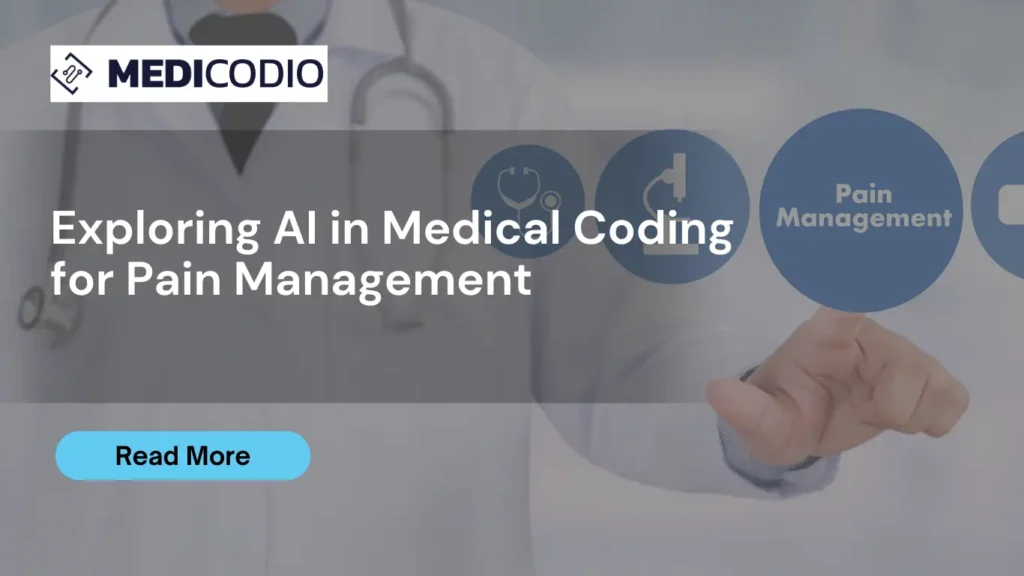Chronic pain is one of the major health issues in the United States. Healthcare providers spend most of their time treating patients with chronic pains. According to the National Institutes of Health (NIH), it’s estimated that between 11% and 40% of US adults suffer from chronic pain.
While healthcare specialists focus on providing patient-centered and coordinated care, they also face increased scrutiny from insurance companies, evolving codes, expanding prior authorization requirements, reductions in fee schedules, and growing financial responsibility for patients.
With the rising number of hospital admissions for chronic pain conditions, emphasizing accurate medical coding becomes more critical than ever.
In this article, we will explore the application of AI in medical coding for pain management.
What are the medical codes for pain management?
The guidelines for coding and reporting in the ICD-10-CM (International Classification of Diseases, 10th Edition, Clinical Modification) include detailed instructions and notes specifically addressing the coding of pain. Pain-related codes are distributed across various chapters within the ICD-10, such as Chapter 6 (G00-G99 – Diseases of the Nervous System), Chapter 7 (H00-H59 – Diseases of the Eye & Adnexa), Chapter 13 (M00-M99 – Diseases of the Musculoskeletal System and Connective Tissue), and Chapter 19 (S00-T88 – Injury, Poisoning, and Certain Other Consequences of External Causes).
Here is the complete information about the medical codes for pain management.
What are the coding guidelines for pain management and treatment services?
The Centers for Medicare and Medicaid Services (CMS) revised coverage and payment of new chronic pain management (CPM) bundled payment codes on January 1, 2023.
CMS has recently concluded the development of new HCPCS codes, specifically G3002 and G3003, along with their valuation for chronic pain management and treatment services (CPM) for the calendar year 2023. The expectation is that the introduction of these CPM HCPCS codes will enhance the precision of payment for these services. Additionally, it is anticipated that more practitioners will be inclined to welcome Medicare beneficiaries dealing with chronic pain into their practices. The intention is also to encourage practitioners who are already treating Medicare beneficiaries with chronic pain to dedicate time to assist them in managing their condition within a trustworthy, supportive, and ongoing care partnership.
The finalized codes encompass a comprehensive bundle of services provided throughout a month, envisioned as the foundational point for holistic chronic pain care. This approach is in alignment with analogous bundled services in Medicare, such as those extended to individuals with suspected dementia or substance use disorders. The CPM codes, in their finalized form, encompass several crucial elements in the code descriptor. These include the diagnosis, assessment, and monitoring of chronic pain, administration of a validated pain rating scale or tool, and the development, implementation, revision, and/or maintenance of a person-centered care plan that incorporates strengths, goals, clinical needs, and desired outcomes.
Furthermore, the finalized codes encompass overall treatment management, facilitation, and coordination of any necessary behavioral health treatment, medication management, pain, and health literacy counseling, any required chronic pain-related crisis care, and continuous communication and coordination among relevant practitioners providing care. This collaboration involves various aspects such as physical and occupational therapy, complementary and integrative care approaches, and community-based care, as deemed appropriate.
Challenges in Medical Coding for Pain Management
Here are 5 significant challenges faced by medical coders in the realm of pain management.
Challenge 1: Portraying The Location of Pain Accurately
Accurately documenting the location of pain is a fundamental yet challenging aspect of medical coding for pain management. Pain can be subjective, and patients might have difficulty describing the precise location. Moreover, pain may radiate, complicating the task of pinpointing its origin. Coders must rely heavily on the information provided by healthcare professionals and be meticulous in their documentation to ensure an accurate portrayal of the pain’s location. Failure to do so can lead to coding errors and potential reimbursement issues.
Challenge 2: Discrepancies in Documentation
Inconsistent or inadequate documentation poses a significant challenge in medical coding for pain management. Physicians may use different terms or descriptors for similar pain conditions, leading to confusion for coders. Additionally, incomplete documentation can hinder accurate code assignment. The lack of detailed information regarding the onset, duration, exacerbating or alleviating factors, and associated symptoms of pain can make it challenging for coders to select the most appropriate codes. Improving communication between healthcare providers and coders is crucial to overcoming this challenge.
Challenge 3: Payer Policies, LCDs, and NCDs
Navigating the complex landscape of payer policies, Local Coverage Determinations (LCDs), and National Coverage Determinations (NCDs) is a constant challenge for medical coders in pain management. Payers may have specific requirements and guidelines for coding pain-related services, leading to variations in reimbursement. Staying abreast of these policies is essential to ensure accurate coding and prevent claim denials. Frequent updates and changes in payer guidelines further complicate the task, requiring coders to be vigilant and adaptable in their approach.
Challenge 4: Difficulty in Specifying Degree and Type Of Pain
Assigning codes that accurately reflect the degree and type of pain is another challenge faced by medical coders. Pain can vary in intensity, and the coding system must capture this gradation. Additionally, distinguishing between acute and chronic pain is crucial for coding purposes, as it influences the selection of appropriate codes. Coders need a comprehensive understanding of pain terminology and classification to ensure precise code assignment, reducing the risk of billing errors.
Why is Medical Coding Essential in Pain Management?
-
- Accurate Billing and Reimbursement: Medical coding serves as the language that bridges healthcare providers and insurance companies. For pain management services, precise coding ensures that healthcare providers are appropriately compensated for their services. Accurate coding prevents revenue loss and ensures a fair reimbursement process.
- Compliance with Regulations: The healthcare industry is heavily regulated, and pain management is no exception. Medical coding ensures compliance with various coding guidelines, such as those provided by the Centers for Medicare and Medicaid Services (CMS). Proper coding helps healthcare providers avoid legal issues and financial penalties.
- Facilitating Data Analysis: Effective pain management relies on comprehensive data analysis. Accurate coding allows healthcare providers to track and analyze trends related to pain conditions, treatments, and outcomes. This data-driven approach enables better-informed decision-making and the continuous improvement of pain management strategies.
- Improved Patient Care: Efficient medical coding contributes to a smoother workflow, reducing administrative burdens on healthcare professionals. When administrative processes are streamlined, healthcare providers can dedicate more time and attention to patient care. This, in turn, enhances the overall patient experience in pain management.
- Enhanced Communication: Medical coding serves as a standardized language that facilitates communication among healthcare professionals, insurance companies, and other stakeholders. Consistent coding practices ensure that everyone involved in the pain management process understands the specifics of each case, leading to better coordination and collaboration.
In the realm of pain management, the role of medical coding cannot be overstated. From ensuring accurate reimbursement to facilitating seamless communication and data analysis, medical coding is the backbone of an effective and efficient healthcare system. Healthcare providers must prioritize proper coding practices to not only meet regulatory requirements but also to enhance the quality of care provided to patients experiencing pain. By unraveling the complexities of medical coding in pain management, the healthcare industry can forge a path toward improved patient outcomes and operational excellence.
Here’s how AI can revolutionize Medical Coding for Pain Management:
1. Accuracy Boost: AI algorithms can analyze vast amounts of medical data, including physician notes, diagnoses, and treatment plans, with lightning speed and impressive accuracy. This reduces human error and ensures proper coding for pain conditions, leading to:
a) Improved reimbursement for healthcare providers
b) More accurate data for research and treatment development
c) Enhanced patient care through better resource allocation
2. Efficiency Unleashed: AI can automate repetitive tasks like code searching and cross-referencing, freeing up coders’ time for complex cases and patient interaction. This translates to:
a) Reduced administrative burden and burnout for coders
b) Faster claim processing and reimbursement cycles
c) Improved overall efficiency in pain management workflows
3. Granularity Unmatched: AI can delve deeper into the nuances of pain, identifying subtle differences in diagnoses and procedures that might be missed by human coders. This leads to:
a) More precise coding, reflecting the true complexity of pain cases
b) Better understanding of pain trends and patterns for improved treatment efficacy
c) Personalized pain management plans tailored to individual patient needs
The future of pain management coding is bright with AI, but it’s a future we must navigate responsibly and collaboratively.
By harnessing the power of AI tools like CODIO, healthcare, and RCM leaders can pave the way for a more accurate, efficient, and individualized approach to pain management.
Boost your revenue and reduce denials with CODIO, an AI-powered medical coding assistant. Get a free consultation and see how it works: https://lnkd.in/gfSJa8Hi





